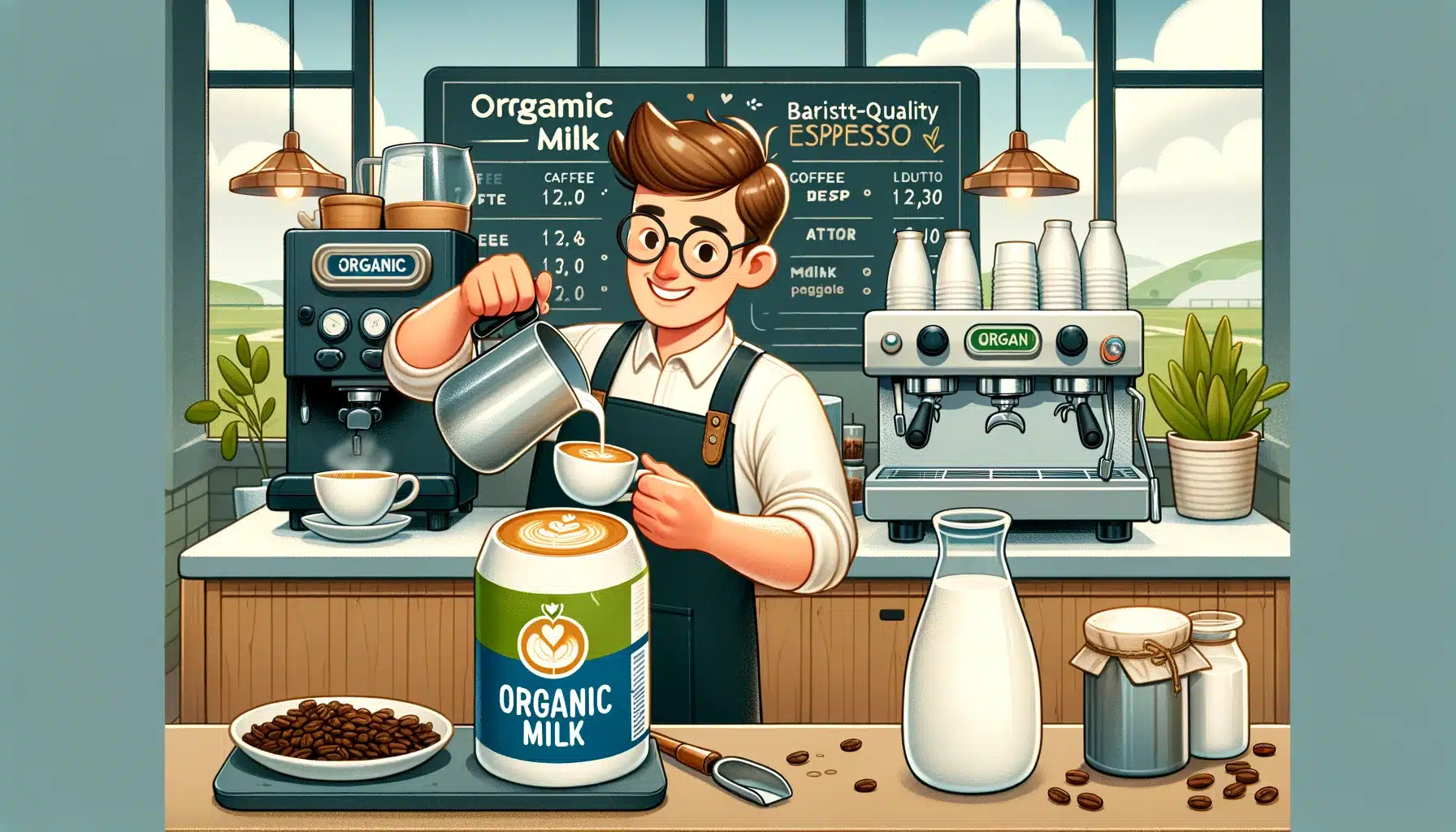Organic Milk for Barista-Quality Espresso. In the world of specialty coffee, the choice of milk can be as critical as the quality of the espresso itself. Organic milk has become a popular choice among baristas aiming to create the perfect cup of coffee. Not only does it bring a natural sweetness and rich texture to espresso drinks, but it also aligns with a growing preference for organic products among consumers. Understanding the unique qualities of organic milk is essential for baristas who want to enhance the flavor profile of their espresso beverages.

Organic milk distinguishes itself from conventional milk through stringent farming practices that prioritize animal welfare and environmental sustainability. These practices contribute to a cleaner and potentially more flavorful product, without the presence of antibiotics, synthetic hormones, or pesticides. For baristas, the ability to froth organic milk into a silky, glossy microfoam makes it a top contender for crafting exquisite lattes, cappuccinos, and other milk-based espresso drinks.
Key Takeaways
- Organic milk’s richness is preferred by baristas for enhancing espresso drinks.
- Ethical farming practices behind organic milk appeal to eco-conscious consumers.
- The textural quality of organic milk is essential for achieving superior microfoam.
The Basics of Organic Milk

Organic milk has become a staple for baristas who aim to serve the freshest and tastiest espresso drinks. Its quality directly influences the end result, marrying flavor and nutrition in a way that is both delicious and wholesome.
What Makes Milk Organic?
Organic milk stems from dairy farms that adhere to strict agricultural practices. They prioritize the welfare of the cows, which graze on pesticide-free pastures and are not treated with hormones or antibiotics. The milk from these cows is then processed without the use of artificial additives or preservatives. As a result, it often retains a fresher taste and more robust flavor than conventional milk.
Nutritional Benefits of Organic Milk
Organic milk isn’t just about improved taste; it also offers a nutritional edge. A well-known fact about milk is its calcium content, essential for bone health, and organic milk is no exception. It is often richer in omega-3 fatty acids due to the cows’ grass-based diet. Furthermore, organic milk typically has higher levels of vitamin D, vitamin A, and iron — all integral for a balanced diet and overall health, making it a valuable addition to any espresso drink.
Espresso Fundamentals
In crafting espresso-based drinks, the selection of milk and the quality of the espresso shot are both crucial components. Each plays a pivotal role in the flavor profile and texture of the drink.
Importance of Milk in Espresso-Based Drinks
Milk is not just a mixer; it’s an ingredient that baristas manipulate to enhance the espresso experience. The right milk can add sweetness, creaminess, and serve as a canvas for beautiful latte art. When steamed properly, organic milk creates a rich, velvety microfoam that can elevate the overall mouthfeel of the beverage. It’s essential that the milk complements the natural flavors of the espresso, harmonizing with the complex taste profile without overpowering it.
The Role of Espresso in Flavor
Espresso, the concentrated heart of an espresso-based drink, determines the foundational flavor. A perfect shot of espresso offers a balance of sweetness, bitterness, and acidity, contributing to the coffee’s taste profile. The crema, the creamy, caramel-colored foam on top, is the sign of a well-extracted shot, indicating freshness and quality of the coffee beans. It’s the barista’s expertise that ensures the espresso’s robust and nuanced flavors cut through the milk, without being diluted.
Milk Types and Alternatives
When crafting barista-quality espresso drinks, the choice of milk can significantly affect flavor, texture, and overall enjoyment. This section explores the differences between dairy and plant-based milks and discusses various alternatives best suited for espresso.
Dairy vs Plant-Based Milks
Dairy milk, sourced from animals, is a traditional favorite for espresso due to its rich taste and ability to create smooth, velvety foam. However, not everyone can enjoy dairy milk due to lactose intolerance or dietary preferences, leading many to seek plant-based alternatives. Plant-based milks offer a variety of flavors and nutritional profiles while being lactose-free, often making them a preferable choice for those with dietary restrictions or environmental concerns.
Popular Milk Alternatives for Espresso
The world of non-dairy milk alternatives is diverse, with each variant bringing a unique quality to espresso drinks. Here’s a brief overview of favored choices:
- Oat milk: Known for its creamy consistency and subtle sweetness, oat milk steams well for a frothy finish, making it a top choice for lattes and cappuccinos.
- Almond milk: With a light, nutty flavor, almond milk is low in calories but can be less creamy than other alternatives. Baristas often reach for the barista edition specifically formulated for better frothing capabilities.
- Soy milk: A classic choice, soy milk steams quite similarly to dairy milk and provides a comparable texture, though it may impart a distinctive taste.
- Coconut milk: While it adds a tropical hint to beverages, coconut milk’s lower protein content can make it challenging to achieve the perfect foam.
- Cashew milk: Cashew milk features a rich and creamy texture with a subdued flavor, allowing the espresso to shine through.
For those looking to replicate that barista-quality espresso at home or in a café, these non-dairy milk alternatives can present both a challenge and an opportunity to get creative with flavors and textures.
Barista Techniques
In the world of espresso making, mastery in barista techniques can significantly enhance the coffee experience. Two key skills stand out: the ability to steam and froth milk to achieve a perfect texture and the precision in pouring that allows for impressive latte art.
Steaming and Frothing for Texture
When a barista begins to steam milk, their main goal is to create a microfoam that gives milk a silky texture and sweet taste. It’s not just about heating the milk; the technique involves introducing just the right amount of air to achieve a velvety consistency that feels smooth on the mouthfeel. Here’s how they do it:
- Purge the steam wand to remove any residual water.
- Submerge the wand just below the milk surface to create froth by incorporating air.
- Sink the wand deeper into the milk jug to continue heating without adding more air.
- Spin the milk in the jug to achieve homogeneous microfoam.
Key points to remember:
- Always start with cold, fresh milk and a clean, cool steaming pitcher.
- The angle of the steam wand and the depth at which it’s submerged are critical for proper frothing.
Art of Pouring for Latte Art
Once they have steamed the milk to a silky microfoam, a barista’s next challenge is the art of pouring for latte art. Precision pouring is essential for creating intricate designs atop the espresso. The key steps are:
- Start with a high pour to mix the espresso with the milk.
- As the cup fills, lower the pitcher closely to the surface to layer the microfoam.
- Move the pitcher through various motions such as wiggling or making circles to shape the design.
Important aspects to consider:
- The velocity and steadiness of the pour influence the outcome of the latte art.
- The contrast between the dark espresso and the white milk froth makes the design stand out.
By focusing on these techniques, baristas elevate a simple cup of coffee into an art form, enhancing both the visual and the sensory enjoyment of the drink.
Recipes for Espresso Drinks
Crafting espresso drinks with organic milk not only enhances the richness of the beverage but also ensures that one is enjoying a product free of pesticides and synthetic contaminants. Each recipe provided here allows for variations using whole milk, skim milk, or half-and-half to cater to flavor and texture preferences.
Classic Organic Cappuccino
A Classic Organic Cappuccino starts with a strong shot of espresso and is then blanketed with equal parts of steamed and frothed organic milk. The velvety microfoam is key to its luxurious texture.
- Espresso: 1 shot
- Organic Milk: 150ml (steamed)
- Organic Milk Foam: 150ml (frothed)
- Begin by extracting a shot of rich espresso.
- Steam the organic milk until it reaches a creamy consistency.
- Froth the remaining milk to create a thick, airy foam.
- Combine the espresso with the steamed milk, and gently spoon the froth on top.
Perfect Organic Latte
The Perfect Organic Latte is for those who prefer a smoother, milkier coffee experience, blending well-steamed milk with a touch of espresso.
- Espresso: 1 shot
- Organic Milk: 200ml (steamed)
- Milk Foam: a thin layer
- Pull a shot of espresso into a warm cup.
- Steam the organic milk until it’s hot and has a slight froth.
- Slowly pour the milk over the espresso, holding back the foam, to create a creamy blend.
- Top with a thin layer of foam. For an Iced Latte, simply cool the espresso and pour over ice before adding cold organic milk.
Selecting the Right Milk
When crafting barista-quality espresso drinks, the milk one selects can greatly influence the taste and texture of the final beverage. Different brands offer unique takes on barista blends, and factors like fat content and mouthfeel are crucial considerations.
Brands and Their Unique Offerings
Several top players like Oatly, Minor Figures, and Rise have developed barista blends that work harmoniously with coffee. Oatly’s barista edition is favored for its creamy consistency and frothing capability similar to dairy milk. Minor Figures also offers a barista oat milk that is designed to foam and texture just right for espresso based drinks. For those looking for something slightly different, Rise produces an oat milk that’s a single-origin product, lauded for its purity and simplicity.
Other brands like Elmhurst and Pacific cater to various dietary preferences while still emphasising quality in coffee. Elmhurst’s barista editions are known for their minimal ingredient lists and rich textures. Pacific offers a barista soy milk and a barista almond milk, each bringing a unique mouthfeel and flavor profile to espresso concoctions.
Considering Fat Content and Mouthfeel
The fat content in milk impacts both the taste and the mouthfeel of a coffee drink. Full-fat options provide a richer, velvety texture, while lower-fat options might offer a lighter feel but less creaminess. For instance, brands like Oatly and Pacific’s barista blends have managed their products to balance the fat content for optimal performance in coffee drinks, ensuring a smooth, creamy finish.
Milk alternatives have to balance fat with other components like fiber to achieve the desired consistency. These fibers can contribute to the stabilization of foam which is essential for latte art. Whether using oat, almond, or another plant-based milk, one should consider the beverage’s final mouthfeel—seeking a milk that complements the boldness of espresso while providing a pleasing texture on the palate.
Environmental and Ethical Considerations

In the realm of espresso, the use of organic milk is not solely a matter of taste but also one of environmental and ethical significance.
Sustainability in Milk Production
Organic dairy farming embraces methods that are designed to be more sustainable. It often involves practices such as lower animal stocking densities and the avoidance of synthetic fertilizers and pesticides, which can result in reduced environmental impact. For instance, a climate-friendly barista milk has been developed from cows fed with a special diet that reduces methane emissions. Organic certification also typically dictates that the cows be fed with organic, plant-based feed, contributing to the reduction of the farm’s environmental footprint.
- Organic Milk Features:
- No synthetic fertilizers or pesticides
- Lower animal stocking densities
- Reduction in greenhouse gas emissions
Ethical Choice for Baristas and Consumers
Choosing organic milk can be seen as an ethical decision for both baristas and consumers. This choice supports farming practices that promote animal welfare and environmental preservation. Moreover, baristas who prioritize the use of organic milk are making a statement about the importance of ethical considerations in their craft. In their quest for the perfect cup, they recognize the importance of how the milk they use is produced. Additionally, by choosing organic options, consumers are indirectly advocating for more sustainable food systems.
- Ethical Considerations:
- Promotion of animal welfare
- Preservation of ecosystems
- Support for sustainable agriculture practices
Advanced Barista Knowledge

In the quest for barista-quality espresso, understanding the intricate relationship between milk and coffee is crucial. Mastering milk’s chemistry and the art of frothing are essential skills for any barista looking to elevate their espresso beverages.
Milk Chemistry and Coffee
Milk consists of water, fat, proteins, lactose, and minerals, each playing a distinct role when mixed with coffee. The proteins, such as casein and whey, are vital for foam stability, forming a network that traps air and creates froth. High-quality, organic milk often contains a balanced composition that favors a creamier texture and can enhance the sweetness of the espresso, especially when dealing with organic milk options.
Fat content, particularly in skim milk, alters the texture and mouthfeel of the coffee. While full-fat milk yields a richer taste, skim milk can be more challenging to work with but still can produce a satisfactory microfoam if handled correctly by skilled baristas. On the other hand, organic milk’s natural sweetness can mitigate the potentially acidic tones of the espresso, creating a smoother and more palatable drink.
Crafting the Perfect Froth and Microfoam
Achieving the perfect froth and microfoam requires a delicate balance of temperature and technique. Microfoam is characterized by its fine, velvety bubbles, which are essential for latte art and contribute to a silky mouthfeel. Baristas aim for a temperature between 140-160°F (60-70°C), as over-steaming can scald the milk and impair flavor.
Key steps to creating ideal microfoam:
- Purge the steam wand to eliminate any residual water.
- Submerge the wand slightly beneath the milk surface, at a 45-degree angle.
- Create a whirlpool effect, introducing air until the milk reaches 100°F (38°C).
- Submerge the wand deeper, continuing the whirlpool until the desired temperature is met.
The proper technique involves brewing the espresso simultaneously or shortly before frothing the milk to ensure peak freshness and temperature of both components when combined. For best results, using skim milk may prove less forgiving, but an experienced barista can still create a glossy and stable microfoam for an exceptional beverage experience.
Case Studies

In the quest for the perfect cup, many factors come into play, but the choice of milk is pivotal. We’ll examine preferences from both the professional and consumer angles to understand how milk selection affects the beloved espresso experience.
Barista Champions’ Preferences
Many barista champions agree that the taste and flavor profile of organic milk deeply influences the final espresso drink. It’s typically described as creamier and more flavorful, which could elevate a good espresso to greatness. They often opt for full-fat organic milk, knowing that it steams better, creating a velvety microfoam that’s ideal for latte art—attributing to a more delicious and aesthetically pleasing coffee experience. Their preferences hint at a nuanced understanding that the milk’s origin can indeed make a break a championship-worthy espresso.
Consumer Preferences for Milk in Espresso
On the consumer side, there is a discernible shift towards organic milk options, predicated on both taste and health considerations. A survey indicates that:
| Milk Type | Consumers Prefer for Taste | Considered Healthier Option |
|---|---|---|
| Organic Whole Milk | 65% | 73% |
| Non-Organic Milk | 22% | 14% |
| Plant-Based Milks | 13% | 13% |
The majority underline organic milk as the gold standard for a rich and favorable espresso. They often cite a fuller body and a natural sweetness that enhances the espresso without overpowering it, aligning with the baristas’ insights for crafting a superior cup.
Supplementary Information

In this section, the reader will find additional details to enhance their understanding of organic milk’s role in preparing barista-quality espresso drinks. It includes terms relevant to milk and coffee as well as solutions to common issues that might arise while working with different milk types.
Glossary of Terms
- Cortado: A small coffee drink that typically combines equal parts espresso and steamed milk to reduce the acidity.
- Americano: A style of coffee prepared by adding hot water to espresso, giving it a similar strength but different flavor from regular drip coffee.
- Milk Products: Refers to dairy items produced from milk, such as whole milk, heavy cream, and skim milk.
- Non-dairy Milk: Milk alternatives derived from plant sources such as oats, almonds, or soy, often used for their unique flavors or by individuals with dietary restrictions.
- Heavy Cream: The richer, higher-fat layer skimmed from the top of milk before homogenization, providing a thick and creamy texture to coffee drinks.
- Nutty: A flavor descriptor indicating a taste reminiscent of nuts, which can sometimes be a characteristic of non-dairy milks.
Troubleshooting Common Issues
Issue: Milk not frothing well
Solution: Ensure that the milk is fresh and cold; non-dairy milks may require different frothing techniques compared to dairy milk.
Issue: Espresso drink tastes too bitter or acidic
Solution: Balance the espresso with the appropriate milk choice; a cortado with organic milk can provide smoothness, while an americano might benefit from only a splash of milk or heavy cream.
Common Considerations:
- Non-dairy milks can separate in the acidic environment of coffee; choosing barista versions of these milks can alleviate this issue.
- Flavor profiles such as nutty can be more pronounced in non-dairy milks, which may affect the final taste of the beverage.
Conclusion

Using organic milk in barista-quality espresso drinks is a choice that reflects not only a commitment to better health and environmental practices but also an investment in the quality of the beverage. Baristas understand that the type of milk used can significantly affect the taste and texture of the espresso. Organic milk typically offers a cleaner taste and superior frothing qualities due to its higher protein content.
- Taste: Organic milk can enhance the flavor profile of espresso, giving it a richer and more balanced taste.
- Froth: It also contributes to a creamy, stable foam that is ideal for latte art and the overall sensory experience of the drink.
Many coffee enthusiasts appreciate the natural sweetness and wholesomeness of organic milk in their espresso, making it a popular choice for those who prioritize organic products. Baristas may find that organic milk steams beautifully, creating a velvety texture that complements the robust nature of espresso.
While the preference for milk types can be subjective, organic milk is often praised for its contribution to a smooth, full-bodied espresso experience. It works in harmony with the coffee to create drinks that are not only delicious but also resonate with consumers who have a preference for organic ingredients.
In conclusion, whether one is a seasoned barista or an at-home espresso aficionado, considering organic milk is a worthwhile exploration to elevate the quality of coffee creations.









